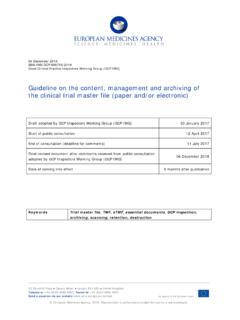Transcription of 3. Health information systems - World Health Organization
1 Health information systems43 Health information systems3. Health information systems44 Health information IntroductionSound and reliable information is the foundation of decision-making across all Health system building blocks. It is essential for Health system policy development and implementation, governance and regulation, Health research, human resources development, Health education and training, service delivery and Health information system provides the underpinnings for decision-making and has four key functions: (i) data generation, (ii) compilation, (iii) analysis and synthesis, and (iv) communication and use. The Health information system collects data from Health and other relevant sectors, analyses the data and ensures their overall quality, relevance and timeliness, and converts the data into information for Health -related decision-making (1).The Health information system is sometimes equated with monitoring and evaluation but this is too reductionist a perspective.
2 In addition to being essential for monitoring and evaluation, the information system also serves broader objectives, such as providing an alert and early warning capability, supporting patient and Health facility management, enabling planning, underpinning and stimulating research, permitting Health situation and trends analyses, orienting global reporting, and reinforcing communication of Health challenges to diverse users. information is of little value if it is not available in formats that meet the needs of multiple users, policy-makers, planners, managers, Health -care providers, communities and individuals. Dissemination and communication are therefore essential attributes of the Health information planners and decision-makers need different kinds of information including: Health determinants (socioeconomic, environmental, behavioural and genetic factors) and the contextual environments within which the Health system operates); inputs to the Health system and related processes (policy and Organization , Health infrastructure, facilities and equipment, costs, human and financial resources and Health information systems ); the performance or outputs of the Health system (availability, accessibility, quality and use of Health information and services, responsiveness of the system to user needs, and financial risk protection); Health outcomes (mortality, morbidity, disease outbreaks, Health status, disability and wellbeing).
3 And Health inequities (determinants, coverage of use of services, and Health outcomes, and including key stratifiers such as sex, socioeconomic status, ethnic group and geographical location). A good Health information system brings together all relevant partners to ensure that users of Health information have access to reliable, authoritative, usable, understandable and comparative Expectations from country Health information systemsHealth information systems serve multiple users and a wide array of purposes that can be summarized as the generation of information to enable decision-makers at all levels of the Health system to identify problems and needs, make evidence-based decisions on Health policy and allocate scarce resources optimally (1). data from different sources are used for several purposes at different levels of the Health -care Health information systems45 Individual level data about the patient s profile, Health -care needs and treatment serve as the basis for clinical decision-making.
4 Health -care records provide the basis for sound individual clinical care. Problems can arise when Health workers are overburdened by excessive data and reporting demands from multiple and poorly coordinated subsystems. Health facility level data , both from aggregated facility level records and from administrative sources, such as drug procurement records, enable Health -care managers to determine resource needs, guide purchasing decisions for drugs, equipment and supplies, and develop community outreach. data from Health facilities can provide immediate and ongoing information relevant to public Health decision-making, but only if certain conditions are met. The data must be of high quality, relate to all facilities (public and private), and be representative of the services available to the population as a whole. Population level data are essential for public Health decision-making and generate information not only about those who use the services but also, crucially, about those who do not use them.
5 Household surveys have become a primary source of data in developing countries where facility-based statistics are of limited quality. Household surveys are needed everywhere, however, because they are the only good source of information on individual beliefs, behaviours and practices that are critical determinants of Health -care use and Health status. Public Health surveillance brings together information from facilities and communities with a main focus on defining problems and providing a timely basis for action. This is especially important when responses need to be urgent, as for epidemic diseases. The need for timeliness of reporting and response and the requirement for effective linkages, to those in authority with the responsibility for disease control, impose additional requirements on Health information of the importance of Health information systems to be capable of generating reliable data is growing. In many countries, Health sector reform and decentralization have brought about shifts in functions between the central and peripheral levels and have generated new information needs with changing requirements for data collection , processing, analysis and dissemination.
6 Health sector reforms also magnify the need for standardization and quality of and results based monitoring, stimulated by unprecedented increases in development assistance and global Health initiatives such as the Global Alliance on Vaccines Initiative (GAVI), Global Fund to Fight AIDS, Tuberculosis and Malaria (GFATM), the United States President s Emergency Plan for AIDS Relief (PEPFAR), and the Roll Back Malaria partnership have increased pressure on governments and organizations to improve their performance and demonstrate tangible results to their stakeholders. In this environment, a premium has been placed on the existence of adequate Health information of good quality. Health information systems are called upon to enable tracking along the continuum of inputs to the Health system , processes and outputs, as well as outcomes and developing countries have sufficiently strong and effective Health information systems to meet all these diverse information needs.
7 New technologies can contribute to improving data generation, compilation and exchange but will require the existence of clear data quality standards to be of optimal Sources of information on country Health information systemsInformation about the functioning of the Health information system can be obtained from the different sectors and agencies that are responsible for the generation, synthesis, analysis and use of data at the country, regional and global levels. At the country level, the ministries of Health record the timeliness and quality of data reported through Health services and disease surveillance systems . National Statistics Offices maintain information on Health information systems46the availability and quality of data generated through major data collection undertakings, such as the decennial census, large-scale household surveys and the civil registration system . As custodians of national official statistics, they often have explicit requirements for the method of data collection , compilation and sharing, and adhere to the Fundamental principles of official statistics devised by the United Nations (2).
8 International agencies working in Health also maintain information about the availability and quality of data on international Health goals, including (but not limited to) the Criteria for assessing country Health information systems performanceCriteria for assessing performance of Health information systems and the quality of data they generate have rarely been defined, let alone implemented. In contrast, in sectors other than Health particularly for macroeconomic and financial statistics considerable work has been done to define standards, guidelines and best practices (see Box ).Box 3 1 Tools to assess the quality of national statisticsThe Organisation for Economic Co-operation and Development (OECD) has developed statistical standards, guidelines and best practices on development indicators (3). Explanatory metadata are collected and published to accompany all data thus enabling users to assess data quality, fitness for use.
9 Based on these metadata, comparability across countries an important aspect of data quality can be national statistics offices have commissioned external reviews of performance to identify strengths and weaknesses and to make recommendations for improvement (4). The United Nations Fundamental principles of official statistics is often used as a general framework to assess the performance of national statistics offices (5). The quality of information is central to its usefulness. information must be reliable, up to date, independent and trustworthy. At the same time, it is important to avoid duplication of efforts and minimize the burden of data collection on front-line staff, so that data are generated with minimal disruption of the delivery of there is wide agreement in the literature on what the components of data quality should be, there is no universal consensus on how to group them. Some authors have proposed headings covering accuracy, relevance, coherence and consistency, continuity, timeliness, accessibility and revisability (6).
10 Others include coherence (especially comparability), availability and clarity (7). Clearly, conflicts can arise between different facets, such as those between consistency and timeliness, and trade-offs must be made. The extent to which statistics meet users needs and expectations for statistical information is widely recognized to be of paramount importance. To allow users to assess the quality of the statistics they utilize, producers of statistics provide neutral, descriptive information about all aspects of statistics that affect users views on how well the statistics might meet their needs and expectations. Health information systems47 The International Monetary Fund (IMF) has developed the General data Dissemination Strategy (GDDS) to help countries in improving the quality of their data (8). The GDDS strategy provides a framework for evaluating needs for data improvement and setting priorities; it provides guidance on dissemination to the public of comprehensive, timely, accessible and reliable economic, financial and sociodemographic statistics.















